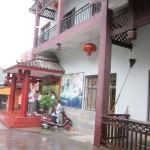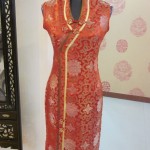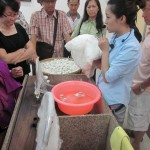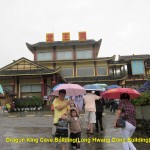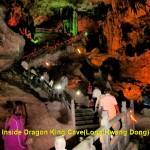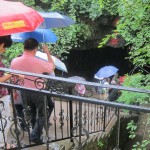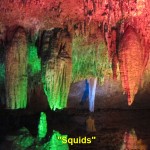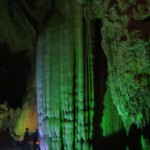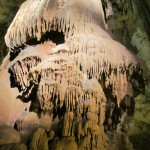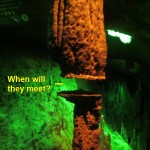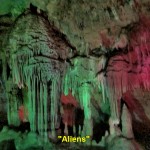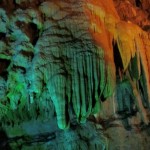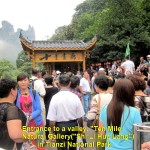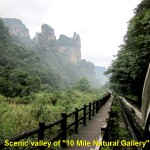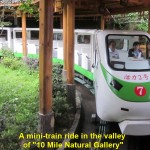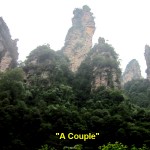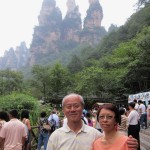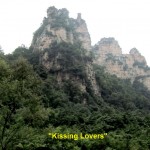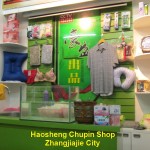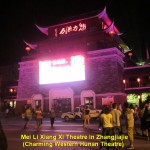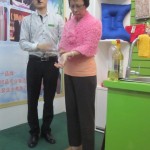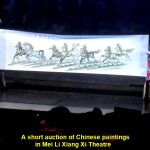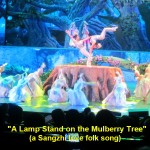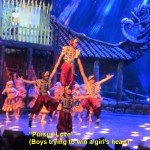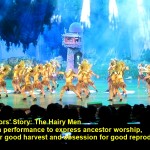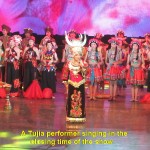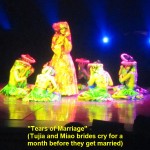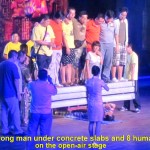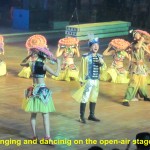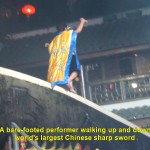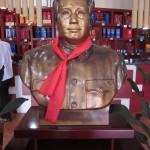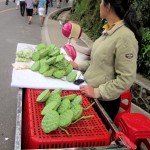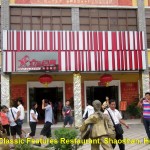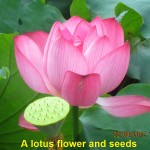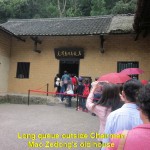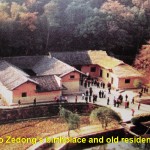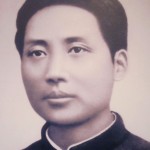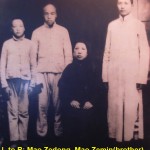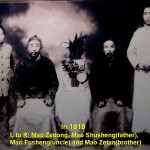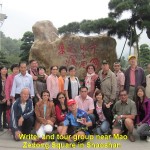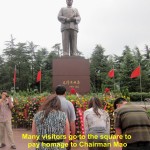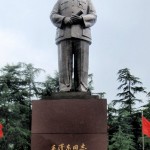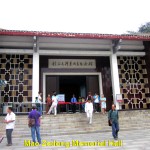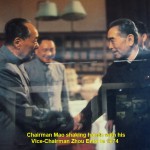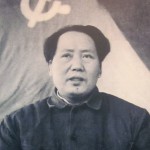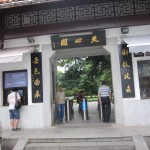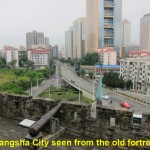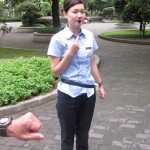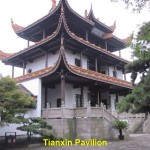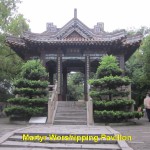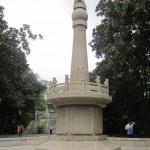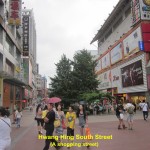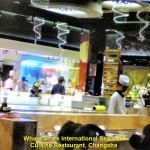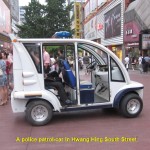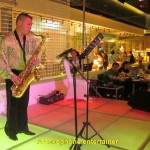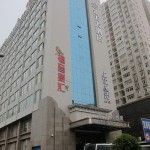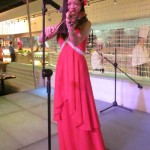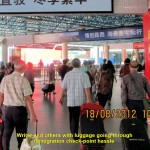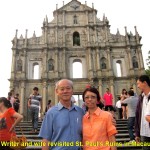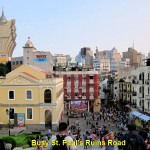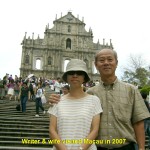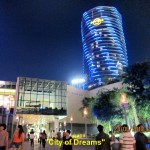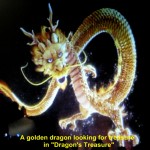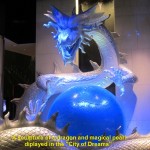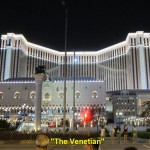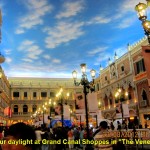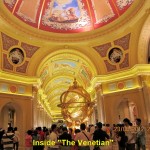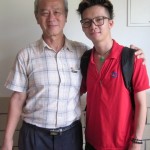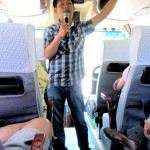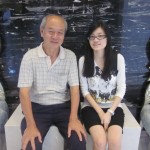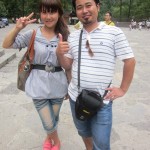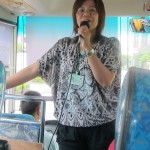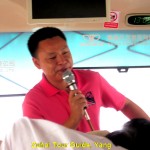Zhangjiajie Travel II
(continue from Zhangjiajie Travel I)
Zhangjiajie Travel II
Day 4 Tuesday 21 August 2012
Silk Product Shop
In the morning, we visited a silk shop in the city. At the shop, we learned about silkworms making cocoons which were then used for making silk cloth and blankets. After that educational lesson, we were persuaded by persistent sales girls to buy silk products. When some of us had bought a few of them, we all left for a tourists’ place of interest, a famous cave in Zhangjiajie.
Dragon King Cave(Long Hwang Dong)
We had to travel east of Zhangjiajie City to the cave that is one of the 100 over caves in Wulingyuan Range. It is known as Dragon King Cave(or “Long Hwang Dong”). Legend has it that a dragon king once lived in that cave, hence the name of the cave. Although the cave is 30 km deep, tourists can go in as far as 3.5 km only.
When we arrived at the cave, it was raining, heavily. Luckily, we were going to spend our time inside the cave in the morning. As it was raining heavily outside, some water seeped through certain parts of the cave-roof and fell onto the long, winding walkway causing some lower parts to be flooded. The walkway ascended and descended several times in the cave. Besides, it passed through a few large cavities or “halls”.
Limestone Figures
Along the long partially-lit trail, we saw stalactites and stalagmites of different shapes and sizes. With a little bit of imagination, we could see the structures that looked like a dragon head, needle, corns, corals, jellyfish, monsters, long beans, and many more. Colour lights were used to enhance the shapes and sizes of the limestone structures. Those awesome rocks mesmerized us.
A Broken Pillar
In the cave, there was an interesting broken cylindrical limestone pillar with a 10 cm-gap between them. Next to it stood a notice board that said “Meet Once in Ten Thousand Years: As the specialist investigated, the stalactites grow one centimeter per hundred years. The middle of the broken pillar is 10 centimeters. It should take 1 000 years if the broken pillar grow together.” Do you think they will join together in about 500 years instead of 1 000 years as stated in the notice? You make a guess.
Foot Massage
Having spent a lot of time in the cave, we left and went to a Chinese medicine shop in the city. On arrival at the shop we were first given a free foot massage which we needed very badly after so much walking for the past few days. After the massage we were introduced by our masseurs a few kinds of natural medicine which the house Chinese physicians claimed to have effective cures for serious health problems. Some of us were convinced by the physicians and bought them, but we did not buy a lot as the products were not cheap at all.
Ten Mile Natural Gallery
Later, we left the shop feeling invigorated by the massage and went to a scenic valley known as “Ten Mile Natural Gallery”(or “Shi Li Hua Lang”). Located north-west of Zhangjiajie City and in the Tianzi Scenic Spot, the valley has many sandstone peaks looking like humans, of course, with some imagination.
In the valley, we took a mini-train to see those towering peaks. Each peak or cluster of them has a name, such as “The Immortals Worshipping Guanyin(Goddess of Mercy)”, “The Herb Collecting Man”, “The Couple”, etc. When the train stopped at the terminal a few km away from the starting point, we got off, walked about and saw more high peaks. Among them were three tall peaks that attracted a lot of attention from the tourists. They were close to each other and looked like sisters. Naturally, they were called “The Three Sisters” like those I saw in the Blue Mountains near Sydney in Australia.
Haosheng Chupin Shop
Later, we went back to the city and visited a shop where daily-used products such as toothbrushes, towels, pillows, under-garments, shawls, socks, etc., were sold. It was known as Haosheng Chupin Shop(or Haosheng Product Shop). While we were sitting in a room of the shop, a young handsome man introduced some of the products to us claiming that they could improve our health.
Charming Western Hunan Theatre
Later, we left the shop and went for dinner at a city restaurant. After the meal, we, immediately, went to Zhangjiajie downtown large theatre known as Mei Li Xiang Xi(Charming Western Hunan) to watch a live local cultural performance. The theatre was packed to capacity. Fifteen minutes before the performance began, an auction of large and long Chinese paintings was held on the stage. Then the performance started.
Spectacular and Dazzling Performance
It was a spectacular and dazzling one involving over 100 energetic young and old performers. It showcased the cultures of the Hunan ethnic minorities of Tujia, Bai and Miaojia in the following musical dramas:
a. The Border Town
b. Pursue Love
c. A Lamp Stands on the Mulberry Tree
d. Ancestors’ Story:The Hairy Men
e. Heroes Return Home
f. The Big Carnival
g. Tears of Marriage
Outdoor Shows
When the 1½ hour-performance was over, we went outside the theatre to watch more shows including stunts, dances and singing. Some of the stunts were dangerous, shocking and unbelievable, like breaking a concrete block on a strong man’s stomach with a hammer, putting three large slabs of concrete on the strong man’s stomach and asking seven adults to stand on them, walking on fire, and walking on a long sharp Chinese sword. Those stuntmen were amazing super-humans, as they emerged from their stunts unscathed.
We have enjoyed all the shows at that theatre as they were varied, entertaining, cultural, educational and splendid. In fact, they were much better than the previous one we saw on our first day in Tianmen Grand Valley. Besides, its tickets were much cheaper.
Soon we returned to Emperor Hotel to rest our tired bodies after a busy long day.
Day 5 Wednesday 22 August 2012
Shaoshan
In the morning we left Zhangjiajie city and travelled south-east to a far place known as Shaoshan. It was the birthplace of the founder of the People’s Republic of China, Chairman Mao Zedong. Chairman Mao governed his country from 1949 until his death in 1976.
After about 5 long hours of travelling on our tour bus, we arrived at a restaurant, Red Classic Features Restaurant, in Shaoshan where we took our lunch. After that deliciouc meal, we went to Chairman Mao’s birth-place which was not far from the restaurant.
Chairman Mao’s Birth-Place, Shaoshan
On arrival at the well-known place, we had to get off our bus and walked a short distance to Chairman Mao’s old house. On the way, we saw many stalls along the road selling fresh lotus seeds and a few ponds filled with large lotus plants. When we reached the house, we saw a long queue of visitors outside. Nevertheless, we queued up and finally entered the old, simple, wooden, large, thatched, single-storey house belonging to Chairman Mao’s wealthy parents. It was in that house that Mao Zedong was born in 1893.
While we were inside, we saw some bedrooms with old furniture. They belonged to Chairman Mao, his parents, brothers and uncles. A pigsty and cow-shed were in the house too. Adjacent to the house was his neighbour’s house. As we were looking into the rooms, some police were watching and warning us and other visitors not to snap any photos inside.
Chairman Mao’s Early Activities
In 1925, Chairman Mao launched the Communist Peasant Movement at Shaoshan and it was at that house that small-scale meetings were often held to find ways to get peasants’ support to overthrow the current government under Kuomintang(KMT-Nationalist Party of China). Later, a branch of the Communist Party of China was established in Shaoshan.
In 1929, KMT confiscated the house. When the communist party took over China in 1949 from KMT, the former preserved and maintained the house. It is now a popular tourists’ attraction as it is a legacy left behind by China’s great leader, Chairman Mao. Many Chinese leaders and people go there to pay homage to him.
Mao Zedong Square, Shaoshan
Later, we walked a few hundred metres to Mao Zedong Square. Standing on a high pedestal in the square is a large bronze statue of Chairman Mao Zedong. It was erected there in 1993 to commemorate Chairman Mao’s 100th. birth anniversary. While we were there, we saw a lot of wreaths placed in front of the statue by visitors. Several people were seen to place more wreaths and they bowed in front of it paying tribute to their great hero.
Mao Zedong Memorial Hall, Shaoshan
Located near the statue was a memorial hall dedicated to Chairman Mao. Opened in 1964 to public, it showcased the life history of Chairman Mao and his family, his struggle against KMT, victory, rule, relationships with foreign countries, policies, etc. It took me a long time to see the exhibits in all the rooms. But, it was a worthwhile visit to learn about the great man who single-handedly united a large country with a population of over 500 millions in 1949 and named her “People’s Rebublic of China”.
Tianxin Park, Changsha
At about 3.30 p.m., we left Shaoshan and travelled north-east to the capital of Hunan Province, Changsha. In the middle of Changsha City, we visited a historical place known as Tianxin Park. At the park stands the remaining an old fortress.
I
n 202 B.C., a mud-wall of several kilometres long was built by a King of Changsha, King Wu Rui. In 1372, the wall was rebuilt with rocks and its length was 8.8 km. Then in 1932, most of it was torn down to give way to the expansion of the city and ring roads. The remainder(about 250 metres long) can still be seen on a hill, Longfu Mountain, at Tianxin Park in the city.
Tianxin Pavilion
On top of the hill stands an ancient building erected during the Emperor Qianlong’s reign(1711-1799). It is known as Tianxin Pavilion. Furthermore, there are some other important structures at the park, such as Chunglie Tower( a memorial monument for those who died in the anti-Japanese war), Chunglie Gate(another memorial monument for the Changsha fallen heroes in the anti-Japanese war), and Martyr Worshipping Pavilion(a memorial monument for the soldiers and officers who died in the Changsha wars against the Japanese from 1939 to 1944), to name a few. Tianxin Park is now a popular place among local people who like to go there to relax and do some recreational activities there, like dancing, practicing martial arts, playing “mahjong”, and exercising.
Hwang Hing South Street, Changsha
From Tianxin Park we went to a shopping street in the city centre known as Hwang Hing South Street. That street flanked by two rows of shops is closed to traffic, and pedestrians or shoppers could walk along it, safely. Besides, police were around in the street to prevent crimes.
We spent a short time browsing in some shops and bought some things that we liked. At 7.00 p.m. we left the street and went to a large restaurant for dinner. For the first time in our tour, we had a buffet-dinner at the restaurant known as Whale Shark International Seafood Cuisine Collection, which is quite a long name for a restaurant.
Shark International Seafood Cuisine Collection, Changsha
That restaurant provided four types of cuisines: Chinese, Japanese, Western and International. We had out over 400 kinds of food to choose from. They ranged from vegetables, noodles, dumplings to fish, oysters, crabs, squids, lobsters and deserts. You name them and it have them. Hence, we were spoilt for choice. But, fearing that my stomach could not take in so many varieties at one time, I chose a few I liked and ate them with relish.
Musicians
As we were eating we were fortunate to be entertained by two musicians who took turn to play their musical instruments which were saxophone and violin. They played some of my old favourite musics such as ”Under the Boardwalk”, ‘Killing Me Softly”, “The Last Waltz”, and “Que, Sera, Sera”.
After that sumptuous meal, we went to a hotel in Changsha City, Kingship Superior Hotel, where we stayed for a night.
Day 6 Thursday 23 August 2012
Immigration Check-Point Hassle
At 9.10 in the morning, we left for Changsha South Station, boarded a high-speed train and returned to Guangzhou Station, a distance of over 700 km away. When we arrived at the station, the same tour coach came, picked us up and brought us all the way to the Zuhai immigration check-point again. Exiting the check-point, we, immediately, entered another check-point, Macau Immigration check-point. (I am wondering why the two check-points close to each other are still there, although Macau is now part of China. It was returned to China in 1999 by Portugal.) Those check-points are a hassle to both domestic and foreign visitors, as they cause much delay to their journeys.
Ruins of St. Paul’s, Macau
Stepping out of the Macau Immigration check-point, we boarded the same Macau tour coach with the same lady-tour guide on board called Siau Lee. Siau Lee brought us to a famous historical site, Ruins of St. Paul’s. My wife and I have gone there before and it was in 2007 we visited the place. (Read about it in this website: Macau Travel )
Arriving at the site, we took a few photos in front of the Ruins of St. Paul’s and then went down to a busy narrow street to buy a few boxes of Macau’s famous biscuits stuffed with almonds for our loved ones in our homeland, Malaysia.
“City of Dreams”
Later, we rushed to the Asia’s largest and world’s second largest casino, The Venetian, located on a reclaimed land, Cotai Strip, in Macau. It was under construction when we visited Macau in 2007. Before we walked to The Venetian, we went to watch an 18 minute 4-D show in a large hemispherical theatre, The Bubble, in a big building known as City of Dreams that was nearby.
“Dragon Treasure”
The show, titled “Dragon’s Treasure”, is spectacular. It has a combination of high definition video, a loud but dynamic music and over 29 000 theatrical LED lights transporting us to a virtual world of four large, fearsome dragons looking for a treasure. The large hemispherical screen brings images of the creatures to life and creates a sense of starling reality for the audience.
“Dragon’s Treasure” is about the story of the dragons that are searching for a large pearl which has magical powers. The experience we had within that dome for 18 minutes was unique, magical and awesome. When the show ended, we felt we were still in the dragons’ world and took sometime to get out of it.
The Venetian, Macau
Then we walked a short distance to The Venetian, a Renaissance Venice-themed 40 storey-building, belonging to Las Vegas Sands Corporation. It houses a casino and hotel resort. The casino on the first floor consists of over 3 400 slot machines and 800 gambling tables, and the hotel has 3 000 suites. Furthermore, The Venetian has a large indoor arena for sports, concerts, televised shows, etc., theatre, area for shopping, food and beverage, and other facilities.
San Luca Canal
There is an interesting place where there is a canal, San Luca Canal. Visitors can enjoy a slow gondola ride for a fee and at the same time listen to Italian songs serenaded by their skilful gondoliers. Besides, there is an unusual place known as Grand Canal Shoppes where the sun does not seem to set.
Departure
At 11.00 p.m., we left The Venetian and headed for the Macau International Airport. After a few hours of waiting, including a delay of one hour, we finally flew off at 4.30 in the morning to Singapore Changi International Airport, and then went back home in Malaysia, safely.
Well, that is all about our Zhangjiajie tour, an unforgettable and enjoyable one that is now added to my long list of travels.
Thanks for reading this tour and hope you have enjoyed it.
Acknowledgement
Here I would like to thank Chiu Travel(Batu Pahat) for arranging the above-mentioned interesting tour, its diligent and efficient tour leader, Lam Boon Teck, assistant tour leader, Eeling Png, China tour guides, Ah Chen, Yang and Siau Lee, China tour bus-drivers, Lee and Cho, the China photographers, Gao Gen Ping and his two colleagues, and lastly but not least the friendly and happy tour members.
The End
Written by Choo Chaw, Kluang, Johor, Malaysia.

